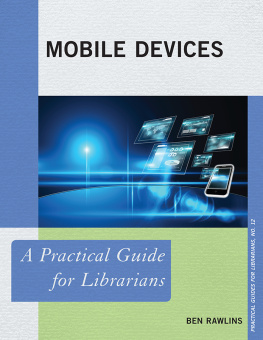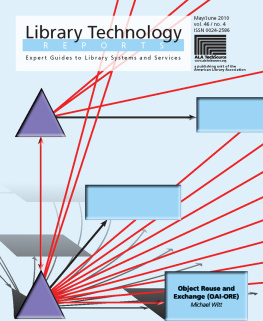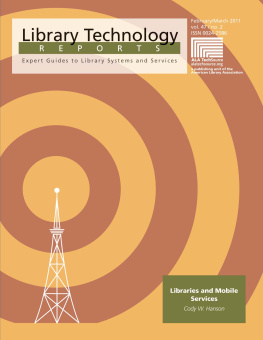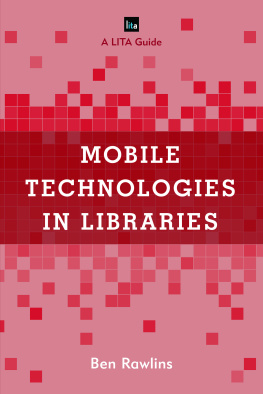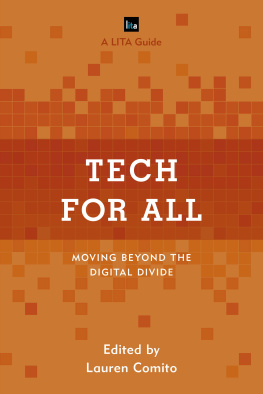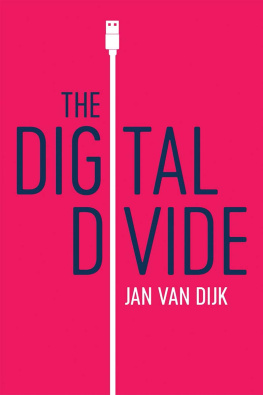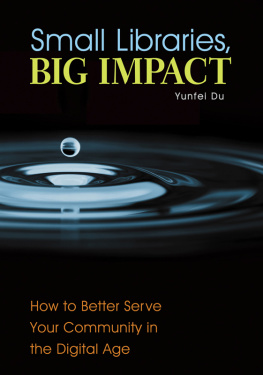Library Technology Reports
Expert Guides to Library Systems and Services
Bridging the Digital Divide with Mobile Services
Andromeda Yelton

alatechsource.org
Library Technology Reports
ALA TechSource purchases fund advocacy, awareness, and accreditation programs for library professionals worldwide.
Volume 48, Number 8
Bridging the Digital Divide with Mobile Services
ISBNs: (print) 978-0-8389-5856-8; (PDF) 978-0-8389-9420-7; (ePub) 978-0-8389-9237-1; (Kindle) 978-0-8389-9237-1.
American Library Association
50 East Huron St.
Chicago, IL 60611-2795 USA
alatechsource.org
800-545-2433, ext. 4299
312-944-6780
312-280-5275 (fax)
Advertising Representative
Patrick Hogan
312-280-3240
Editor
Dan Freeman
312-280-5413
Copy Editor
Judith Lauber
Production and Design
Tim Clifford, Production Editor
Karen Sheets de Gracia, Manager of Design and Composition
Library Technology Reports (ISSN 0024-2586) is published eight times a year (January, March, April, June, July, September, October, and December) by American Library Association, 50 E. Huron St., Chicago, IL 60611. It is managed by ALA TechSource, a unit of the publishing department of ALA. Periodical postage paid at Chicago, Illinois, and at additional mailing offices. POSTMASTER: Send address changes to Library Technology Reports, 50 E. Huron St., Chicago, IL 60611.
Trademarked names appear in the text of this journal. Rather than identify or insert a trademark symbol at the appearance of each name, the authors and the American Library Association state that the names are used for editorial purposes exclusively, to the ultimate benefit of the owners of the trademarks. There is absolutely no intention of infringement on the rights of the trademark owners.

alatechsource.org
Copyright 2012 American Library Association
All Rights Reserved.
About the Author
Andromeda Yelton is a member of the founding team at Gluejar. She is a 2010 Simmons GSLIS graduate interested in the intersection of people, technology, and information. Yelton is a 2011 ALA Emerging Leader and a 2010 winner of the LITA/Ex Libris Student Writing Award.

Abstract
Although mobile devices in libraries have been a hot topic, they are often discussed in the context of affluent populations and academic libraries. The demographics of mobile Internet users are much more diverse than this, and the potential for mobile services is correspondingly broad. speculates on future possibilities, grounded in existing projects, and provide guidance for librarians looking to develop technological capacity. Wherever possible, the focus of the issue is on services that can be implemented quickly and cheaply.
Contents
Abstract
The demographics of mobile Internet users run partly counter to stereotype, with blacks and Hispanics more likely than whites both to own cell phones and to use a wide range of their data features. However, minorities, the young, and people with low income and education are more likely to access the Internet only from their phones. This differs from the desktop Internet experience in ways that have implications for library values.
Google smartphone user. Click on Images. What do you see?
When I tried this, I saw some graphs, pictures of devices (many of them BlackBerrys), and a bunch of white people, mostly men, using smartphones, often to do business. The problem: this is a lie. It doesnt represent the devices people use, or whos using them, or how.
As I researched this Library Technology Report I discovered that many of the assumptions I had made about smartphone use, based on media images like these as well as the usage patterns of my social and professional circles, were wrong. I believe these assumptions are wrong in ways that have civic and moral significance for the provision of library services. In this LTR, Ill walk you through the current state of smartphone ownership and use; discuss a variety of mobile services that can be implemented to serve diverse populations; and address why it is important that libraries do so.
Before I do, its worth noting that mobile does not mean just smartphone. Ive mostly limited my scope to smartphones since theyre devices with both fairly high (and increasing) market penetration and a variety of capabilities. However, they are not the whole picture. There are mobile services that can be delivered on feature phones. There are other Internet-enabled mobile devices, albeit often more expensive ones with lower market share, such as tablets and e-readers. Ill reference these occasionally as well, and I encourage readers to think broadly about device types and carefully observe which ones their patrons are usingespecially since the picture will be different by the time you read this.
The best source of data on Americans and their mobile devices is the Pew Internet & American Life Project. The data in the next paragraph come from the Mobile Access 2010, its most recent report as of this writing. However, the project regularly issues updates, so do check for the most recent data.
Over 80 percent of American adults own a cell phone of some sort (either smartphone or feature phone), and 40 percent of adults (that is, around half of cell owners) access the Internet, e-mail, or instant messaging from their phone. This is a substantial increase over 2009, when only a third of adults used their phone for such access. Indeed, over that one-year time period, cell owners increased their use of a wide range of their phones features. Taking pictures and texting are the most popular phone features, but all features in the Pew survey showed statistically significant one-year growth. In fact, Pew added additional categories to the survey in 2010 to catch up to cell owners rapidly changing usage patterns.
Of these, a substantial and growing number are smartphone users. According to comScore, as of July 2011 there were 82.2 million smartphone subscribers in the United States. Thats almost four million additional smartphone owners in one month.

Figure 1
Market share by OS. Data for May 2010 does not include Apples iPhone launch. As of July 2011, Palm data was no longer reported. Source: comScore data on smartphone platforms from news releases on U.S. mobile subscriber market share dated from Feb. 2010 through Aug. 2011; available at http://tinyurl.com/6u56yms.
Whats driving this? As someone who held out on purchasing a smartphone until April 2011, in part because I was intimidated by the iPhones cost, I have a hypothesis. My Android phone, after rebate, was around $50nowhere near that scary iPhone price point. In fact, as of August 2011, Sprint, Verizon, T-Mobile, and AT&T were all advertising free smartphones. Like mine, these are Android phones (iPhones are still expensive); they may be free only after a rebate, hence requiring some up-front expense, and the deal may be available only to new data subscribers. And, for people who have been accustomed to voice-only phone plans, a data plan is a significant added expense. Nonetheless, with these caveats,
Next page

